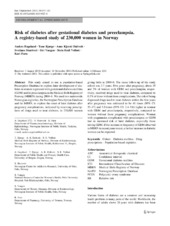Risk of diabetes after gestational diabetes and preeclampsia. A registry-based study of 230,000 women in Norway
Engeland, Anders; Bjørge, Tone; Daltveit, Anne Kjersti; Skurtveit, Svetlana; Vangen, Siri; Vollset, Stein Emil; Furu, Kari
Peer reviewed, Journal article
Published version
Permanent lenke
https://hdl.handle.net/1956/5229Utgivelsesdato
2011-02-06Metadata
Vis full innførselSamlinger
Originalversjon
https://doi.org/10.1007/s10654-010-9527-4Sammendrag
This study aimed to use a population-based Prescription Database to explore later development of diabetes in women registered with gestational diabetes mellitus (GDM) and/or preeclampsia in the Medical Birth Registry of Norway (MBRN) during 2004–8. We used two nationwide Norwegian registries, the Norwegian Prescription Database and the MBRN, to explore the onset of later diabetes after pregnancy complications, indicated by receiving prescriptions of drugs used to treat diabetes, in 230,000 women giving birth in 2004–8. The mean follow-up of the study cohort was 3.7 years. Five years after pregnancy, about 19 and 2% of women with GDM and preeclampsia, respectively, received drugs used to treat diabetes, compared to 0.5% of those without these complications. The risk of being dispensed drugs used to treat diabetes within the first years after pregnancy was estimated to be 41 times (95% CI: 35–47) and 3.0 times (95% CI: 2.4–3.6) higher in women with GDM and preeclampsia, respectively, compared to women without these pregnancy complications. Women with pregnancies complicated with preeclampsia or GDM had an increased risk of later diabetes, especially those having GDM. If the increase in frequency of GDM observed inMBRN in recent years is real, a further increase in diabetic women can be expected.

